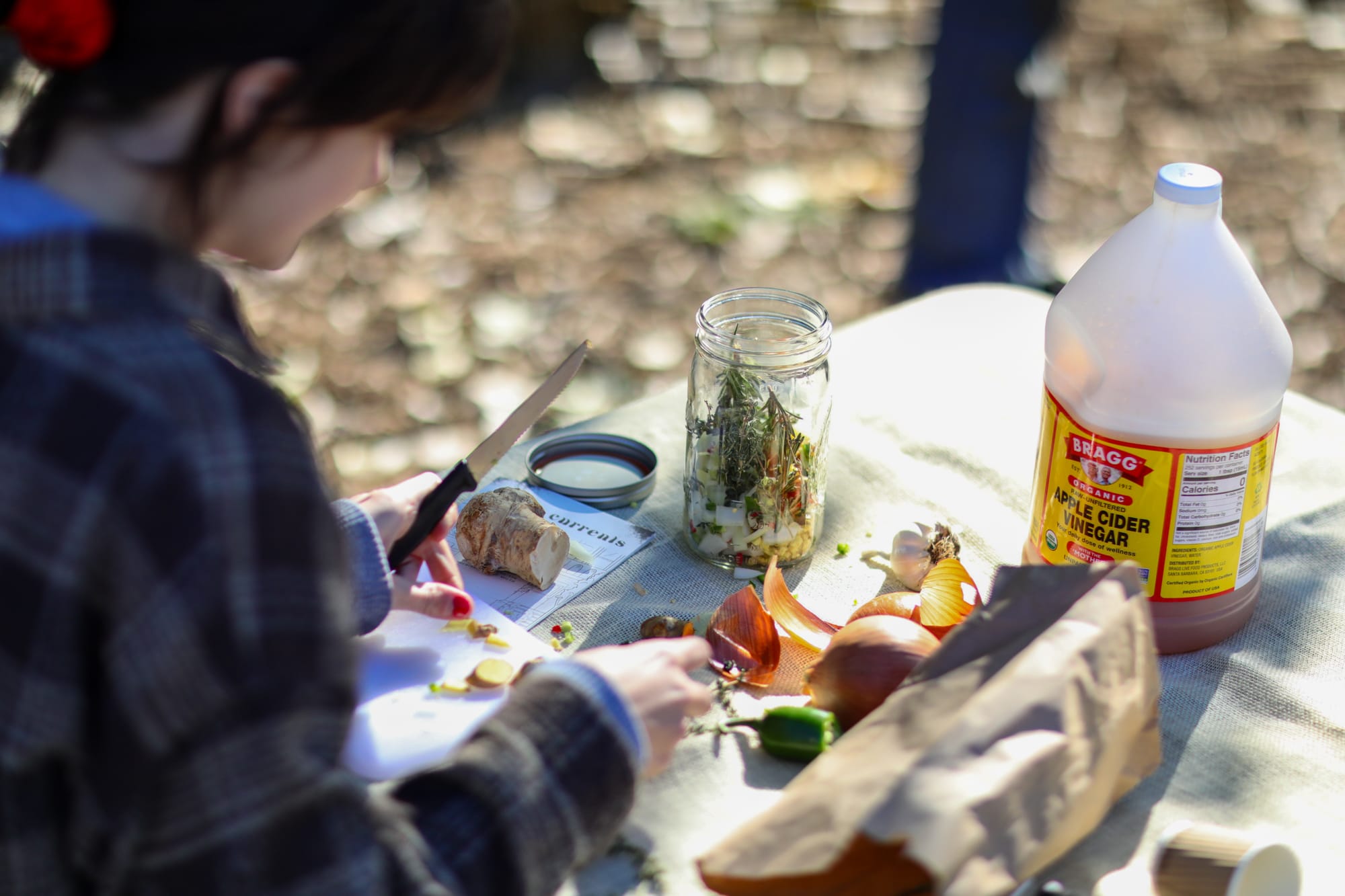Herbal Vinegars
Vinegar extracts, called “acetums” (vinegar is acetic acid) are often used as a non-alcoholic replacement for tinctures. Given a side-by-side comparison of an alcohol tincture and vinegar extraction, the vinegar extraction will be far inferior in terms of the breadth of compounds extracted, but acetums are able to extract some compounds well that alcohol extracts poorly.
Minerals, for example. Vinegar extracts minerals wonderfully. This is why vinegar makes such a great cleaning product, as it is able to remove hard water (mineral rich) deposits from sinks and such. So, using vinegar to extract nutrients from mineral rich herbs is a good idea, as alcoholic tinctures don’t extract minerals very well.
The Delight of Vinegar
Vinegar is a kitchen staple that has been consumed medicinally for thousands of years. The word vinegar comes etymologically from the French word ‘vinaigre’ which means ‘sour wine’. And the history of vinegar is intricately linked to the discovery and production of wine: for example, if wine is left open to air, it rapidly becomes acidic and it turns into ‘sour wine’.

From a 2009 article by Jacques F. Bourgeois and François Barja:
“The first recorded mention of vinegar was in around 3000 B.C., when the Babylonians used the fruit and sap of the date palm as raw material to produce alcoholic beverages. They were transformed naturally into vinegar in contact with air. The Babylonians used it as a food and as a preserving or pickling agent. Residues of vinegar were found in Egypt in urns dating back to 3000 B.C. Texts about vinegar dating from 1200 B.C. have also been found in China. In ancient Greece, in about 400 B.C., Hippocrates, the father of modern medicine, recommended cider vinegar mixed with honey to treat coughs and colds. All through the ages, diluted vinegar has been used as a vitalizing and energizing tonic.” (Jacques F. Bourgeois and François Barja, 2009, The History of Vinegar and of its acetification systems, p.148).
Vinegars are quite the workhorse in the apothecary and kitchen and one of the oldest infusion methods. Vinegars can be utilized in cooking, baking, botanical beverages, hair care, and homemade cleaning products. For the vinegars we take internally, I tend to use raw apple cider vinegar for its bioregionality, beneficial bacteria, health benefits and flavor.
Raw, unfiltered apple cider vinegar is widely consumed for gut health. It contains beneficial gut microbiome promoting bacteria and can assist in digesting and absorbing nutrients. Similar to honey, diluted vinegar is considered an excellent daily tonic for keeping seasonal allergies at bay since the beneficial bacteria vinegar supports immunity and lymphatic drainage.
Studies have also shown that 1-2 tablespoons of vinegar diluted in water before a meal can help keep blood sugar levels stable.
I tend to employ the use of mineral rich herbal vinegars in the spring, when many tender mineral rich herbs emerge from the ground. These herbs are often lymphatic and nourishing and allow the body to reset after the slow movement and inwardness of winter.
Vinegar as a solvent
Unfiltered vinegar is medicinal on its own in addition to being a good solvent for herbs rich in alkaloids, minerals, and pungent aromatics. It is always best to dilute vinegar before consuming.
Vinegar extractions typically have a shelf life of 1-2 years if they are kept in ideal conditions: a cool, dark place without fluctuating temperatures.
You can use fresh or dried herbs to make infused vinegars, but it is well accepted by herbalists that vinegar extracts dried herbs better than fresh (like water infusions, the water content present in fresh herbs inhibits the extraction process and dilutes the final product).
For cleaning products, you can use distilled white vinegar.
You can also learn to make your own vinegars with fallen fruit and vegetables, but I haven’t learned much about that yet, so we won’t cover it, but know it’s possible if you wanna go full scratch!
Making Herbal Vinegars (aka 'acetums')
I like to employ the folk method when making my vinegars. For home and hair care products, I tend to use dried herbs. When I’m making a health tonic, and when available, I will use a combination of fresh and dried herbs, while acknowledging that I might need to use more fresh herbs to account for water content.
Vinegar does not extract the widest breadth of medicinal constituents, but it is excellent at extracting alkaloids, minerals, and pungent aromatics. For this reason, it is often beneficial to add to alcohol tinctures at about 10% if extracting something rich in alkaloids or minerals, such as lobelia or nettle.
As for some preparations we can make with vinegar alone, there are only a few since I always tend to use vinegar in combination with honey, which opens up a wide array of possibilities.
For vinegar alone, however, I tend to make non alcoholic bitters blends, mineral extractions for hair rinses or just mineral shots, and home cleaning concentrates with distilled white vinegar.
So here’s a simple method for making a mineral rich acetum.
How to make an Herbal Vinegar (acetum):
- Combine recently dried, mineral-rich or alkaloid-rich herbs in a mason jar and pour enough apple cider vinegar over them to cover by an inch or so (herbs will often float to the top and protrude over the surface of the vinegar, so I will often weigh them down with a fermenting stone)
- Let macerate for a 2-4 weeks, shaking every few days or so, and strain.
A tonic such as this can offer a great replacement for commercial trace mineral supplements. You can add this vinegar to salad dressings, sautés, beverages, or anywhere that you might use regular vinegar, including as a hair rinse!
Acetic Tinctures
Vinegar also extracts alkaloids especially well. Alkaloids are, for the most part, very powerful chemicals found in plants that end in “-ine”. Nicotine, morphine, lobeline, berberine, and sanguinarine are examples. Adding vinegar along with alcohol when making a tincture of these herbs will create a more powerful extract.
How to make acetic tinctures:
Lobelia, which contains the alkaloid lobeline, is a great candidate for an acetic tincture.
You would follow the mathematical approach for making an alcoholic tincture, except using apple cider vinegar where you would use water in a tincture. For example, if dried lobelia calls for a 1:5 ratio at 50% alcohol, you might combine 100g of dried Lobelia with 250ml of 190 proof alcohol and 250ml of apple cider vinegar. (This is just an example, if you are working with Lobelia, make sure you know what you are doing, using no more than 1-5 drop doses at a time).
For a more mathematical and also more balanced acetic tincture, I tend to follow the ratio recommendations, but only employ vinegar in 10% of the overall menstruum. Using the example above (Lobelia at 1:5 (dry), 50% alcohol) I would combine in a beaker, 50% alcohol, 40% water, and 10% apple cider vinegar. So if using 100g of Lobelia to 500ml of meenstrum, I would combine 250ml 190 proof alcohol, 200ml water, and 50ml ACV. This helps to pull out additional alkaloids and minerals, while making for a more palatable tincture.


Member discussion